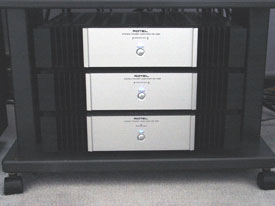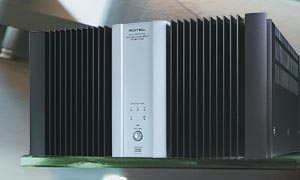 Little Rotel Amps Pack Big Sound
Little Rotel Amps Pack Big Sound
By Jim Bray
February 20, 2007
The heart of a home theater system is the power amplifier, and the better your heart, the better your performance.
Most mainstream home theaters use a combined preamp/tuner/amplifier (also called a receiver), sometimes with a DVD player built in as well. But any combination like that is a compromise, with too many different components being asked to do too many jobs in too little space. The best way to go, if you have the money and your home theater is important enough to your lifestyle, is to buy separate components and let each do what it excels at.
This is especially true of the power amplifier. The problem is, amplifiers traditionally tend to be hulking beasts, big and heavy and putting out a lot of heat. For example, my usual reference amp, Rotel’s RMB-1095, weighs about 75 pounds and is about 10 inches high. It pumps out five channels of splendid sound, each with 200 watts (at 8 ohms) – but as a "traditional amplifier", it also sucks back electrical power and puts out heat. Before I had a dedicated electrical circuit installed, every time I fired it up the lights would dim for an instant.
But now there's a newer type of amplifier that offers the sound quality you want with the size, weight and efficiency you’d expect from the onward march of technology. These are the "Class D" amplifiers, sometimes called digital although they aren’t really, and they may revolutionize the audio industry.
 I had my first experience with a Class D amp when Rotel sent me their RMB-1077 (right), a little wonder that pumps 100 watts into seven channels, is less than 3 inches tall, and only weighs about 17 pounds. It also consumes one third of the power that the big RMB-1095 amp does, while putting out such warm and mellow sound that I quickly grew to love it. To this day, a RMB-1077 is the heart of our "small" home theater.
I had my first experience with a Class D amp when Rotel sent me their RMB-1077 (right), a little wonder that pumps 100 watts into seven channels, is less than 3 inches tall, and only weighs about 17 pounds. It also consumes one third of the power that the big RMB-1095 amp does, while putting out such warm and mellow sound that I quickly grew to love it. To this day, a RMB-1077 is the heart of our "small" home theater.
For those who think bigger, or who require more power, Rotel also manufactures a couple of other class D amps. The RB-1092 and RB-1091 each crank out a whopping 500 watts (at 8 ohms), the former into two channels and the latter into one. This is serious oomph, kind of like upgrading from a V-8 engine to a V-12.
According to Rotel, the RB-1092 can drive "virtually any pair of loudspeakers to very loud sound pressure levels when required." But what really got the wheels turning in my head was this: "When combined with an RB-1091 and another RB-1092 for a five-channel home theater system, the sonic result is absolutely breathtaking."
The thought of having two 500 watt stereo amps and a 500 watt mono amp (a total of 2500 watts!) was irresistible, so I contacted my friends at Rotel and they were kind enough to indulge me.
 The changeover was interesting. After raising a sweat pulling out the RMB-1095 (right), facilitated by a thoughtful set of wheels Rotel mounts on its bum, I unpacked the three Class D’s and stacked them, the three together taking up approximately the same real estate as the one amp I had removed. Together, the trio weighs about 15 pounds less than the RMB-1095, and the stack of silver front panels bounded by black is about as pretty as you can get on an amplifier.
The changeover was interesting. After raising a sweat pulling out the RMB-1095 (right), facilitated by a thoughtful set of wheels Rotel mounts on its bum, I unpacked the three Class D’s and stacked them, the three together taking up approximately the same real estate as the one amp I had removed. Together, the trio weighs about 15 pounds less than the RMB-1095, and the stack of silver front panels bounded by black is about as pretty as you can get on an amplifier.
Even better, in one swell foop I had gone from a darn fine 200 watt per channel home theater to an awe-inspiring 500 watt per channel home theater – with no increase in space requirement, with less weight and (I assumed, since I hadn’t turned them on yet) less heat. Wow!
Or, to paraphrase Disney: "Put them together and what have you got? Bibbidy, bobbidy – BOOM!!!"
Rotel achieves these feats by using what are called ICEPower modules. A Bang and Olufsen innovation, ICEPower is a "switching power conversion technology" in which, basically, the power supply is turned on and off very quickly as the amplifier operates. The inventors call it Intelligent, Compact and Efficient" (ICE, see? Cool acronym!) and claim the ICEPower modules need little cooling and offer superb sound at a competitive price.
I won’t dwell on the technology because, quite frankly, I don’t understand it myself. But I do like the results, at least as Rotel has achieved them.
 In my setup, the RB-1092 (right) twins and the RB-1091 drove a set of five Definitive Technology speakers and before I started my listening tests we calibrated the system using a sound meter.
In my setup, the RB-1092 (right) twins and the RB-1091 drove a set of five Definitive Technology speakers and before I started my listening tests we calibrated the system using a sound meter.
Listening material included a variety of DVD-Audio discs as well as some CDs I knew would be up to the task – a blend of everything from The Doobie Brothers to Medeski Martin and Wood, airplane flybys, a cathedral organ and other reference material designed to test a system's mettle.
Video material included some DVD concerts I love to play loud as well as such standards as the Fifth Element and The Incredibles. I even tried the DVD of The Who’s 2006 visit to my town, a concert I attended and which would be an excellent test for the playback quality of the Rotels – and of my memory.
These amps rock! There’s a sense of energy, of effortless performance, almost as if the amps are saying "Come on, is that all you got?" I kid you not; this is Big Sound. During the most outrageous of my listening tests, the amps pumped out truly stunning levels of sound – but it was never "ear bleeding" or fatiguing; instead, it was just plain glorious and I reveled in it! And yet the power supply conditioner I ran them through (Rotel's RLC-1040) never even approached 50 per cent of its capacity, according to its front panel readout.
Remember, too: some of the material I used was recorded in stereo, so two of the amplifiers weren’t even being used much of the time – yet the room was always filled with high quality sound that seemed limitless.
Particularly rewarding were the concerts, especially The Who concert, which at the appropriate level on the volume scale sounded very much like it did when I was at the actual event. Ditto for the Cream reunion concert. I had never experienced that level of involvement before from a recording. I especially loved the crack of drumsticks on drums, the twang of electric guitars and the clear openness of the human voice.
The overall sound is tight and transparent, from deep bass to "dog territory". The sound is silky smooth, clean and delightful, with a beautifully expansive soundstage (in stereo or multichannel modes) with which you can identify individual instruments clearly and where they are in the "virtual" room.
Listening to some of my favorite recordings through the Rotels brought new enjoyment, letting me notice nuance I’d never heard before, even on albums I’ve played a hundred times or more. On the DVD-A of Queen's "A Night at the Opera," for example, I heard overdubs that had been lost in the mix until then.
Oh, and if you're looking for concussion from explosions, guns and battles, you've definitely come to the right place.
 You don’t have to play it loud, of course; in fact these amps sound grand at regular listening volumes as well. But if you’re looking for a bottomless pit of power these babies just may be your ticket.
You don’t have to play it loud, of course; in fact these amps sound grand at regular listening volumes as well. But if you’re looking for a bottomless pit of power these babies just may be your ticket.
The only flaw, and this is common with audiophile equipment, is that the sound is so clean it'll reveal flaws in the original source material.
It’s a bit strange getting this much great sound from amplifiers that put out such a small amount of heat. We’ve been accustomed to spending quality family time gathered around the big Rotel RMB-1095, warming ourselves by it on cold winter nights. Now, thanks to these Rotel Class D amps, we’ve had to start firing up the old wood burning fireplace instead.
There goes the environment!
Incidentally, the amplifiers feature two sets of conventional speaker cable binding posts, which is great for those who like to bi-wire their speakers and there’s also a set of the new Speakon single wire connectors. You can also control the amps with a 12V trigger.
Such quality doesn’t come cheap, of course. The RB-1092 retails for $2500 U.S. and the RB-1091 goes for $1500 U.S. – so a five channel set up such as I’ve been experiencing gets into some serious coin. But considering what you get, from a sound quality/overall performance and power output standpoint (let alone the space efficiency), they don’t seem overpriced.
And you know, for the first time in my life I haven’t been wondering what it would be like to have just a little more power. Who’d have thunk it?